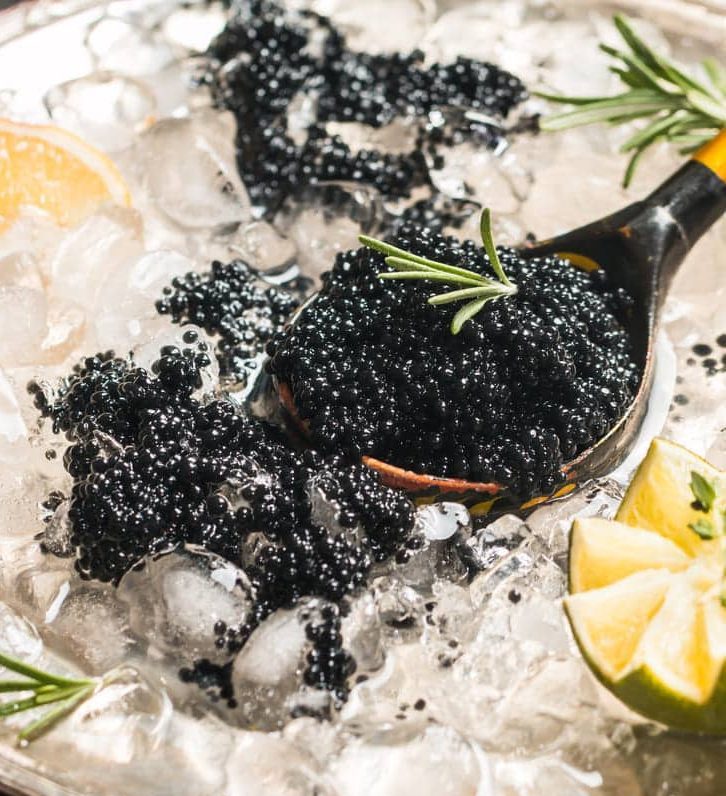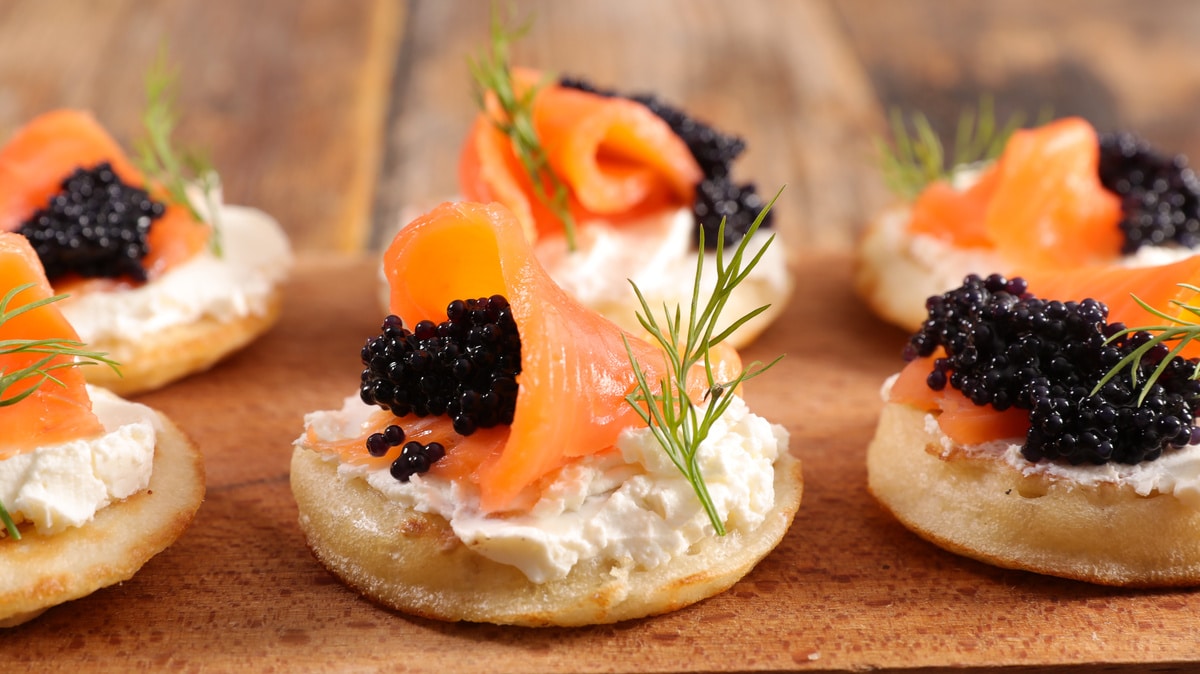
When it comes to fine dining, caviar is considered one of the ultimate indulgences, so if you’re seeking to impress a loved one or spoil yourself, these appetizers are sure to please. For those who don’t know, caviar is a delicacy made from fermented fish eggs. Caviar production, the type and grade of Caviar you choose depend on your budget, occasion, and tastes. The Caviar of choice for generations has been sturgeon caviar, which is one of the most sought-after among gourmets and chefs alike. Among the alternative caviars worth trying are Salmon Caviar, Arenkha, and Lumpfish Roe.
What is Caviar?
Sturgeon eggs are typically used to make caviar, which is salt-cured. Zinc, iron, and selenium are among the minerals found in this high-protein, high-fat food.
Traditionally, caviar is served as an appetizer or spread. Caviar is typically made from sturgeon roe found in the Black Sea and the Caspian Sea. Additionally, caviar refers to salmon, trout, steelhead, lumpfish, carp roe or the eggs of other sturgeon species. Depending on the source, the roe can be fresh, non-pasteurized or pasteurized, though pasteurization reduces its nutritive and taste value.

Different types of caviar
Beluga caviar
An opulent variety of caviar, Beluga sturgeon caviar is renowned for its buttery flavour. In the Caspian Sea, Beluga sturgeons typically reach maturity after 20 years. This is what gives Beluga caviar its rich taste, and this is why it has a bigger size than other caviars. If you would like to truly experience the distinctive taste, serve it over ice.
Oscietra caviar
The Oscietra sturgeon comes in a variety of grades with exciting flavours. There are notes of nuttiness in the caviar, which is salty and creamy at the same time. Greyish eggs of the Siberian sturgeon are medium in size and offer a well-rounded flavour. Try these high-grade, light brown eggs with some blini and a little crème or with quail eggs as a refined, yet sumptuous starter.
Sevruga
Compared to other types of imperial caviar, female sturgeon caviar has a unique taste. While the Sevruga eggs are a smaller size and have a stronger taste, they still retain the buttery texture caviar is known for. During the 6 years it takes for the Caspian sturgeon to mature, its caviar takes on a richer colour and a saltier taste.
How Caviar is made
Beluga Caviar, Osetra Caviar, and Sevruga Caviar are the most popular and expensive caviars. Caviars vary in saltiness, size, appearance, tastiness, aroma, and other attributes.
There are a lot of pleasures and luxuries to be found in this world of sophistication. It would be a good idea to try caviar if you have the chance, mainly because it is one of the most refined delicacies available.
Latest caviar harvesting method
A sturgeon’s caviar comes from its insides. This process uses cutting-edge technology to yield the final product. Caviar is harvested from the sturgeons or fish.
Since wild Caviar is being overfished, it’s becoming increasingly popular to cultivate farmed Sturgeons and harvest the eggs commercially. Aquaculture is used worldwide to raise sturgeon for Caviar. During this process, sturgeons are given the right environment and nourished from an early age to ensure they grow to their full potential.
A quality test is conducted once a female sturgeon ovulates. A variety of processes are used to assess egg quality, such as biopsies, and ultrasound scans.
In this process, the ovaries or row sacs of the fish are examined with ultrasound, individually, after the fish are sedated. As part of the next stage, the caviar is collected, separated based on colour, texture, or size, and ready for retail.
Classic harvesting method
It is traditional to capture the sturgeon while it is alive and make caviar out of it. The ovarian sacks are removed after it has been struck.
Separating the eggs from the membrane is accomplished by passing the roe through a sieve. Afterwards, caviar is categorized based on its size, denoting different price categories.
The treatment will last a few minutes, depending on the concentration. A final step is to refrigerate it at a temperature of -3 degrees Celsius.
What does Caviar taste like?
Caviar is a favourite of connoisseurs, but it is often avoided by food enthusiasts. Though it’s perfectly normal to be sceptical, caviar tastes nothing like what one might expect a fish egg to taste like. The question is, just how does caviar taste? Delicious, of course! It’s complicated, but it’s also interesting.
Even though a fish produces caviar, it shouldn’t taste too fishy. The taste of caviar is similar to ocean water rather than a fishy taste. The taste is always mildly fishy and slightly salty. Ideally, caviar should be fresh and mild, not too intense, but rather rich and buttery. It’s not good quality if it smells and tastes very fishy and salty.
It is a delight to eat great caviar. Each bead feels distinct from the next as it moves along your tongue and slides through your palate. A bite of caviar releases a burst of flavour and it tastes smooth without being oily.

Buttery and nutty flavours characterize high-quality caviars, such as Osetra and Sevruga caviar. It is important to note that the flavour profile of each tin will differ significantly. A sturgeon’s species, its origin, the water quality in which it swims, its diet, and even its age influence the flavour of its caviar. A mature sturgeon produces the best caviar.
Is Caviar good for you?
In addition to being calorie-dense, caviar is a rich source of nutrients like protein, vitamin A, vitamin B12, vitamin B6, and vitamin C. Furthermore, it contains calcium, magnesium, iron, and amino acids, as well as plenty of omega-3s that reduce inflammation.
Caviar is nutritious because that’s what it is! Caviar’s nutritional benefits are also countered by its high cholesterol and sodium content, so you should consume it in moderation to avoid overindulging.
What is the best type of Caviar?
All Sturgeon varieties have large eggs, but Beluga Caviar is the priciest. A note of walnut is present in the roe, making it nutty and buttery to the taste. Additionally, it is considered to be the best caviar by a large number of experts. Our recommendation is to taste a few kinds of Caviar first, so you can decide which one you like best.
Storing Caviar
It is important to keep caviar cold so that its texture and flavour remain intact. As soon as you receive your order, refrigerate it until you are ready to consume it. As some caviar is unpasteurised, it must always be kept cool to maintain its rich flavour all year round.
How to eat Caviar?
Presentation
It is recommended that premium caviar is kept very cold by serving it in a non-metal bowl enclosed in an ice-filled bowl. Because caviar does not freeze until temperatures drop below 28°F, it can be stored at the bottom of the fridge without getting frozen.
You should avoid using metallic bowls or utensils with caviar, as they will make it taste metallic. To be as traditional as possible, use pearl and gold dishes and cutlery, along with tortoiseshell, bone, plastic, and wood materials.
What to serve with Caviar
For connoisseurs, the caviar should be eaten alone to be able to appreciate the delicate taste, placed on the fingers with a spoon to avoid covering it up. Using your tongue, bite into the pearls to release their flavours.
For dinner parties, caviar makes a delicious canape or starter. Combine with plain foods such as blinis or melba toast to enhance caviar’s unique flavour. The dish is also delicious accompanied by a piece of premium fish or topped with sour cream and chopped chives.
Several accompaniments are commonly served with this dish, including slices of lemon, sour cream, crème fraîche, chopped onions, and boiled eggs.
Smoked salmon is also a great accompaniment to caviar. The fresh fillet can be stretched, topped with caviar, and then rolled up. You’ll love it.
Drink pairing
It is essential to choose the right beverage to pair with caviar when eating it. Cold vodka is the most classic drink. Caviar’s flavour won’t be tainted by the unobtrusive flavour of premium vodka.
A common practice, however, is to serve it with wine or champagne. Whenever you choose Champagne, make sure it is the driest type you can find.
A helpful tip for cleansing your palate when exploring new flavours is to use still or sparkling water. Other drinks can still be combined well with caviar as an appetizer.

Popular Caviar recipes
Roasted new potatoes with caviar
The classic recipe for caviar pays tribute to the role potatoes have played as caviar partners. With their multitude of colours and sizes, as well as the perfect balance of soft and spongy textures, new potatoes are irresistible.
Sturgeon with caviar, fennel and dill oil
Despite being rare in the UK, sturgeon is a delicacy in other countries, such as Russia. A good accompaniment to the meaty fish would be tender, roasted fennel, a dill-infused fennel sauce, topped with caviar.
Caviar canapés
You can use the canapé format to wow your guests, particularly with sturgeon caviar on hand.
Sea trout with asparagus, peas and caviar
A simple recipe for sea trout and asparagus is enhanced with the addition of caviar.
The best alternatives to caviar
Though salmon trout roe has a similar texture to caviar, it is not considered caviar. These fish roes are typically used in sushi and as a garnish on fish dishes as a substitute for fish eggs. Also, the colours are a lot more varied, including red lumpfish roe, eye-catching addition to any meal.
How do caviar and fish roe differ?
To maintain the flavour characteristic of caviar, eggs from sturgeon fish should be left unpasteurized and consumed immediately. The roe from other marine species is not considered caviar, regardless of how similar it may appear to the roe of the sturgeon. A sturgeon’s quality and type can have a significant impact on the taste and price of caviar. Caviar of the highest quality is larger and, thus, can be kept intact for longer. In addition to the briny saltwater flavour, the eggs also offer a variety of fruity and nutty flavours.
Sustainability of Caviars
As a result of over fishing, non-sustainable harvesting, and unregulated caviar trade, the Sturgeon population is in decline. To prevent further overexploitation of Sturgeon stocks, CITES (The Convention on International Trade in Endangered Species) banned trade in wild Caviar worldwide.
Supplying caviar is not permitted in the UK due to this universal ban, thus the Caviar you can find at many online stores is obtained from top-quality farms worldwide. It is sourced from farms that use modern methods to ensure both ethical farming and sturgeon conservation.